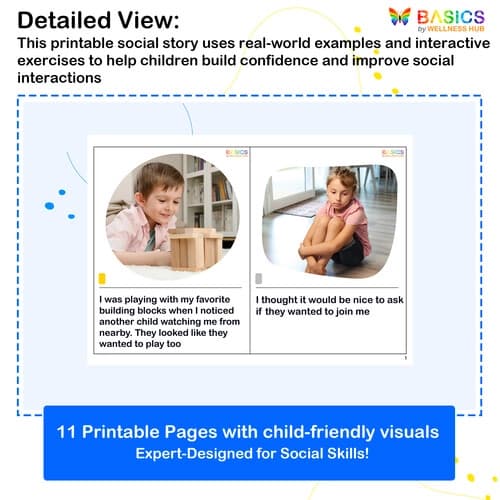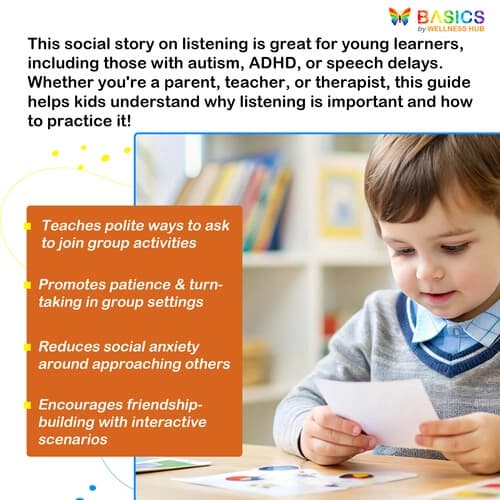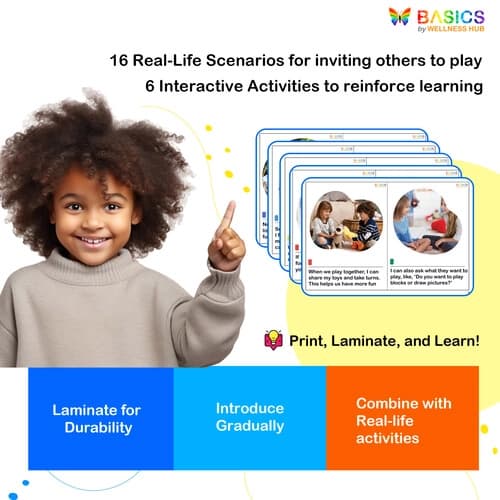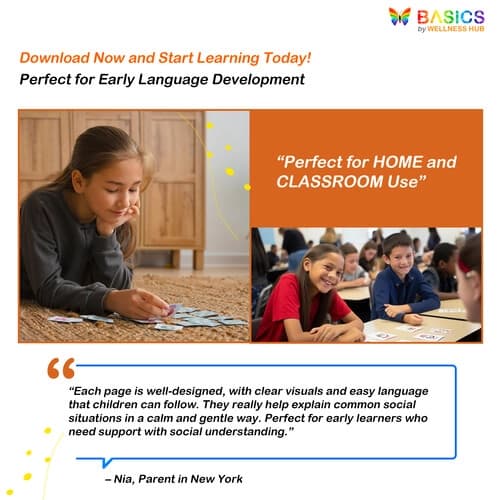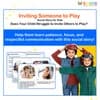

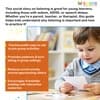
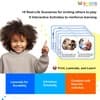
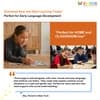
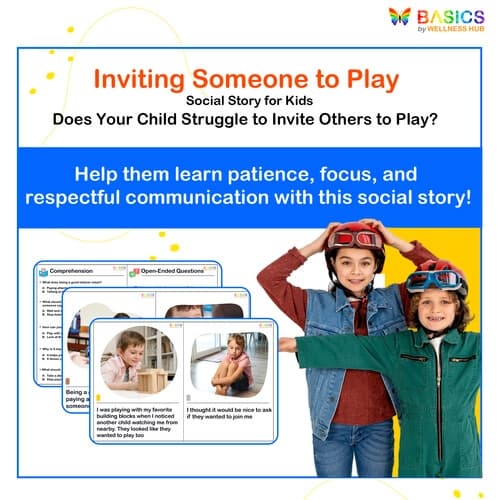
Inviting Someone to Play – Social Story for Kids’ Social Skills
₹80
₹160
50% off
0 (0 ratings)
Grade Levels
Pre-K - Grade 3 (Ages 4-9)
Content Overview
Format: Printable PDF, Total Pages: 11, Features: 16 real-life segments, interactive activities, engaging illustrations, and first-person storytelling to teach how to invite others to play and make friends.
Categories
Pages from the Resource
This free printable social story helps children learn how to invite others to play. With 16 real-life scenarios, interactive activities, and engaging illustrations, children learn the best ways to start a conversation, ask politely to join in, and make new friends. Perfect for kids with autism, ADHD, and social-emotional challenges.
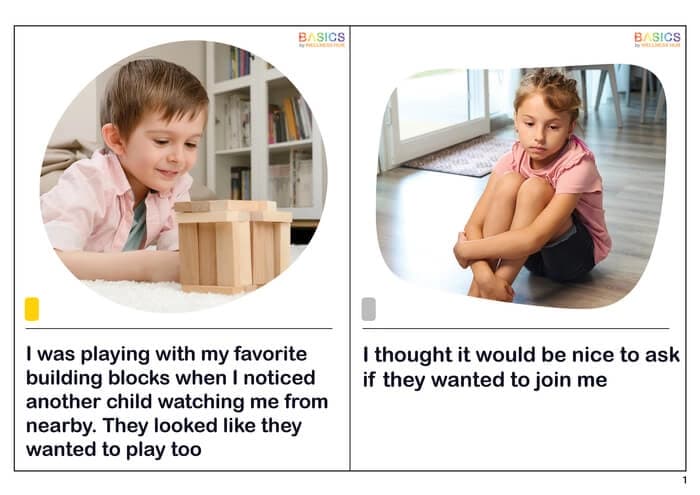
Page 1
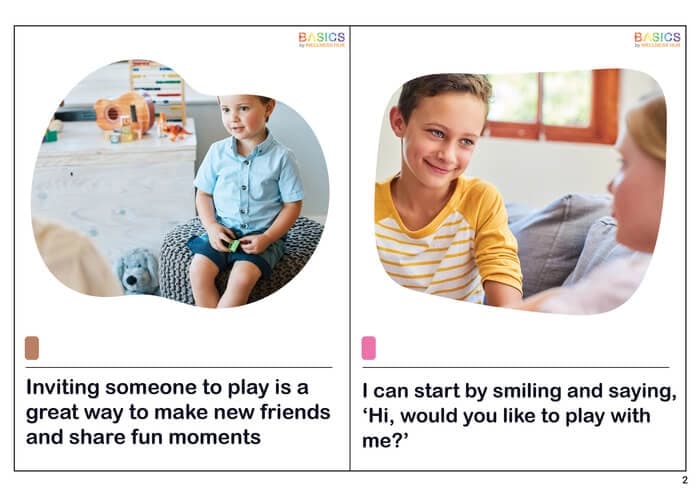
Page 2
What Users Say
0
0 ratings
5
0+
4
0+
3
0+
2
0+
1
0+
5 Stars
Product is Good to use.
1 year ago
Varsha Parent
Similar Products
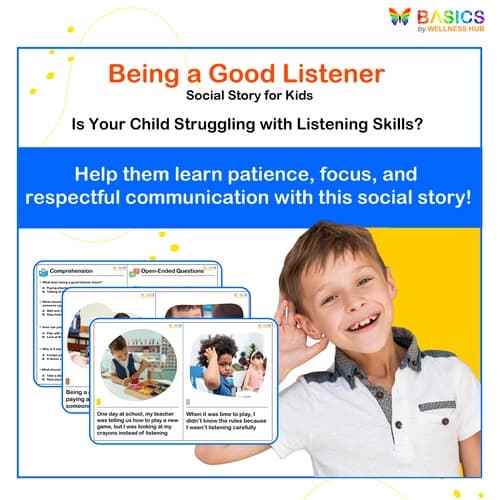
Being a Good Listener – Social Story for Kids’ Communication Skills
₹ 80.00
₹ 160.00
50% off
4.8 (44 ratings)
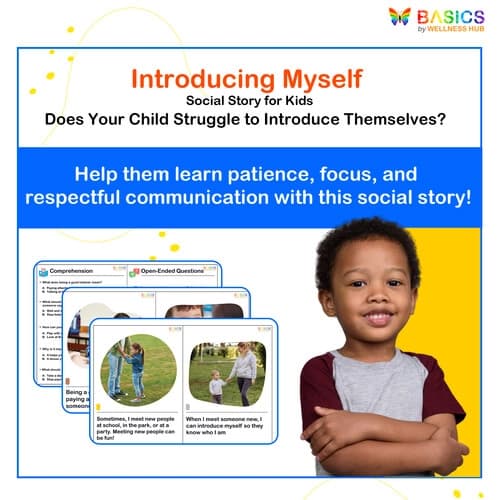
Introducing Myself – Free Social Story for Kids’ Communication Skills
₹ 80.00
₹ 160.00
50% off
4.8 (60 ratings)
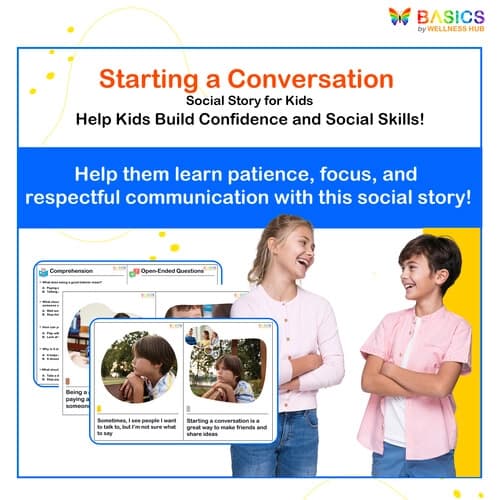
Starting Conversations – Social Story for Kids' Communication Skills
₹ 80.00
₹ 160.00
50% off
5.0 (56 ratings)
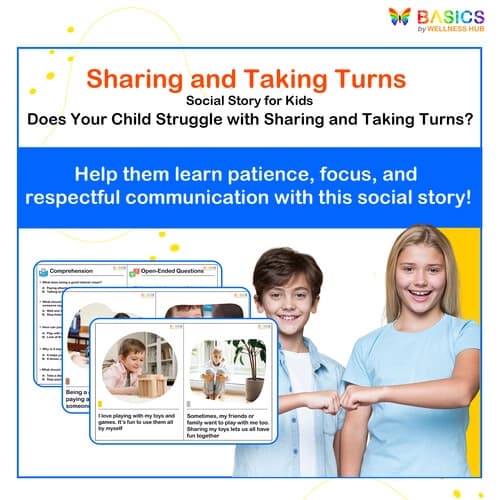
Sharing and Taking Turns – Social Story for Kids’ Social Skills
₹ 80.00
₹ 160.00
50% off
4.9 (42 ratings)
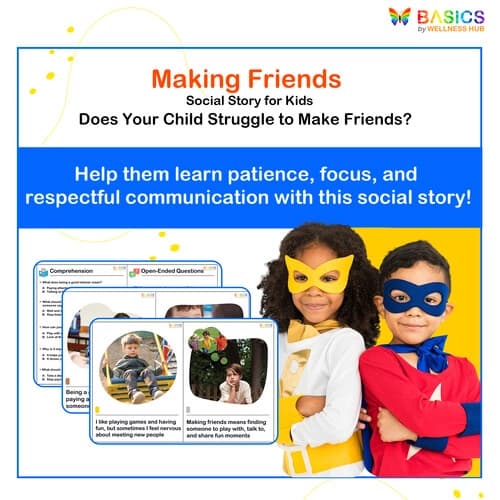
Making Friends – Social Story for Building Social Skills
₹ 80.00
₹ 160.00
50% off
4.9 (52 ratings)
About the Product
Introduction
Social interaction is a fundamental part of children's development, especially when it comes to making friends and participating in group activities. However, for many children, the process of inviting others to play or even knowing how to approach others can be a challenge. This difficulty is often magnified for children with autism, ADHD, or other social-emotional challenges who may struggle with initiating and maintaining peer interactions.
The "Inviting Someone to Play" Social Story is designed to teach children the key steps in starting conversations and inviting others to join play activities. Through 16 relatable, real-life scenarios, this social story provides clear and easy-to-understand guidance for children to practice these important social skills. By using a first-person narrative, engaging illustrations, and interactive activities, children can learn how to confidently approach peers, ask politely to join in, and be part of group play.
Whether used in the classroom, therapy sessions, or at home, this resource helps children develop vital communication skills and empathy, ensuring they can build positive, lasting friendships.
Product Details
- Format: Printable PDF
- Total Pages: 11
- Segments: 16 real-life social scenarios, with detailed illustrations and simple text to reinforce the concept of inviting others to play and the steps to join a group.
- Features:
- First-person perspective storytelling to make the child feel personally involved in the scenarios.
- 16 real-life scenarios that show how to approach peers, ask to join a game, and share in a friendly manner.
- Engaging illustrations that enhance understanding and add a visual element to the learning experience.
- Interactive activities that allow the child to practice key social skills through role-playing and other hands-on exercises.
- Clear, simple language that is developmentally appropriate for children ages 4-9.
- Helpful tips and discussion prompts for parents, teachers, and therapists to encourage conversations about social behaviors and communication.
Educational Benefits
This social story is designed to address several key aspects of social and emotional development. Below are the main educational benefits this resource offers:
1. Teaches Key Social Skills
✔ How to approach others and initiate conversations in a friendly manner.
✔ How to invite peers to play politely and effectively.
✔ Developing patience by learning how to wait for a turn and respecting others' space in group activities.
✔ Understanding group dynamics and how to fit in by recognizing when it’s appropriate to join in.
2. Builds Communication Confidence
✔ Encourages children to speak up and interact confidently with peers.
✔ Promotes active listening and understanding non-verbal cues in social interactions.
✔ Helps children navigate social hierarchies and understand the give-and-take of communication.
3. Supports Emotional Development
✔ Teaches empathy by encouraging children to think about how others feel when joining a group.
✔ Reduces anxiety around approaching peers or inviting others to play by breaking the process into simple steps.
✔ Provides role-play activities to practice managing emotions in social settings, such as feeling shy or rejected.
4. Ideal for Children with Social-Emotional Challenges
✔ Designed with children with autism, ADHD, or social challenges in mind.
✔ Guided, step-by-step approach helps children learn social norms in a clear, structured way.
✔ Useful for special education, speech therapy, and early childhood education programs to address social skills development.
5. Promotes Positive Peer Interactions
✔ Helps children build social confidence by encouraging them to join group activities and make friends.
✔ Reinforces the importance of respecting others' turns and building cooperative play.
✔ Aids in developing long-term social strategies that children can use across various settings (home, school, community).
Instructions for Use
The "Inviting Someone to Play" Social Story is a simple, yet effective tool that can be used in multiple settings. Here’s how to maximize its use:
1. Read the Social Story Aloud
- Begin by reading the social story aloud to the child.
- Focus on pausing after each scenario to discuss what the child observed and how the character acted.
- Ask open-ended questions such as:
- “How would you feel if you were the one asking to join?”
- “What is a nice way to invite someone to play?”
2. Use Role-Playing for Practice
- After reading each scenario, role-play the situation with the child.
- Use props, toys, or even fellow students/children to demonstrate how to approach peers and invite them to play.
- Practice polite phrases such as “Can I play with you?” or “I would like to join you in your game.”
3. Encourage Real-Life Practice
- After the child has learned the basics from the social story, encourage them to practice in real-life situations.
- At school: Ask the child to invite a friend to join an activity.
- At home: Create opportunities for the child to invite siblings or family members to play a game.
- During therapy: Role-play joining group games with the therapist or group members.
4. Incorporate Interactive Activities
- Use the interactive activities to reinforce the lessons learned in the story.
- Activity 1: Role-play joining a game, where the child practices asking to join, waiting for their turn, and engaging in the activity.
- Activity 2: Create a “social scenario match-up” where the child matches the appropriate response to a situation (e.g., “You want to play a game” → “Ask politely if you can join”).
5. Consistent Review and Reinforcement
- Revisit the story weekly or as needed to reinforce the skills.
- Use the story as a tool for discussing specific situations where the child may have experienced challenges in social interactions, and apply the lessons from the social story to those situations.
- Encourage positive reinforcement by praising the child when they successfully invite others to play in real-life scenarios.
Activities Using the Resource
1. Role-Playing Group Play Invitations
Objective: To practice inviting someone to join a group activity.
- Materials: No additional materials required; the social story is the primary resource.
- How to Play:
- After reading the story, act out a few scenarios where the child practices inviting a peer to play. Use the child’s favorite toys or characters to make it fun and relatable.
- Encourage the child to practice saying polite phrases like “Can I join your game?” or “Would you like to play with me?”
- Discuss the appropriate body language and tone of voice that makes an invitation friendly and welcoming.
2. Matching Social Scenarios and Responses
Objective: To identify appropriate ways to invite someone to play and understand social context.
- Materials: Printable matching scenario cards (included with the resource).
- How to Play:
- Present the child with a set of social scenario cards and corresponding response cards.
- The child will match scenarios such as “You see a group of children playing a game” with the appropriate response: “Ask if you can join” or “Wait for a turn.”
- After the matching exercise, have a discussion about why the chosen responses are correct and how they promote positive social interactions.
3. Group Participation Chart
Objective: To track the child’s progress in engaging with others and participating in group activities.
- Materials: Printable group participation chart (included with the resource).
- How to Play:
- Create specific goals for group interaction (e.g., “Join a group activity once a day” or “Ask a peer to play”).
- After each successful interaction, mark it on the chart.
- Offer positive reinforcement like stickers, praise, or a reward after completing a goal (e.g., “joining two group activities in one week”).
- Use the chart to track growth and discuss progress during conversations with the child.
4. Turn-Taking and Patience Exercise
Objective: To reinforce the concept of waiting for a turn during group play.
- Materials: No additional materials required.
- How to Play:
- Create a simple turn-taking game with multiple players (such as board games, group play, or even a waiting game like “Simon Says”).
- Emphasize the importance of waiting for your turn while others are playing.
- Encourage the child to ask politely to join in and reinforce patience by praising them when they wait calmly for their turn.
5. Reflection and Discussion Prompts
Objective: To encourage the child to reflect on their feelings and interactions during group play.
- Materials: None required (just the social story).
- How to Play:
- After a playdate or group activity, ask the child reflective questions such as:
- “How did you feel when you joined the game?”
- “What did you say to ask to play?”
- “How did the other children respond?”
- Discuss what went well and what could be improved. This reflection process reinforces the learning experience and helps the child evaluate their social interactions.
- After a playdate or group activity, ask the child reflective questions such as:
FAQs
Q1: Who is this social story designed for?
A1: This social story is ideal for children aged 4–9 years, particularly those who have social-emotional challenges, such as autism, ADHD, or social anxiety. It’s also useful for children who struggle with joining group activities and making friends. Teachers, therapists, and parents can use this story to support social skills development.
Q2: How do I use this social story effectively?
A2: To maximize its effectiveness:
✔ Read the social story aloud to the child, pausing at each key point to discuss the actions and feelings in the scenarios.
✔ Use the role-playing activities to practice real-life situations where the child needs to ask to join a group or initiate play with peers.
✔ Encourage the child to apply what they’ve learned in daily social settings (school, playground, home) by revisiting the story regularly.
✔ Use positive reinforcement (praise, stickers, or rewards) when the child successfully invites others to play or waits for their turn.
Q3: How does this social story benefit children with autism or ADHD?
A3: The "Inviting Someone to Play" Social Story is especially beneficial for children with autism, ADHD, or other social-emotional challenges because it provides clear, structured guidance for initiating group activities. The first-person narrative and engaging visuals make it easier for children to understand social expectations, while the interactive activities provide opportunities to practice social skills in a safe and supportive environment. Additionally, it helps children with impulse control and anxiety about group interactions by breaking down the process into manageable steps.
Q4: Can this resource be used in schools or therapy settings?
A4: Yes! This social story is perfect for schools and therapy settings, where children may need extra support in developing social skills. Teachers, therapists, and support staff can use this story to help children practice inviting others to play, as well as taking turns and interacting in groups. It can be used in group therapy sessions, special education classes, or classroom activities.
Q5: What are the interactive activities included in the resource?
A5: The resource includes 6 interactive activities that focus on different aspects of joining a group:
✔ Role-playing various scenarios, such as asking to join a game or waiting for a turn.
✔ Matching social scenarios to appropriate responses, helping children identify how to ask politely to join a game.
✔ Turn-taking exercises where children practice patience in group play.
✔ A group participation chart to track progress and encourage ongoing social interactions.
✔ Reflection and discussion prompts to help children evaluate and learn from their social experiences.
Q6: Can I adapt this resource for different age groups?
A6: While this social story is designed for ages 4–9, it can be easily adapted for older or younger children by adjusting the language and complexity of the activities. For older children, you can increase the level of detail in the scenarios or add more advanced social concepts. For younger children, you may choose to focus on simpler scenarios and use more visual cues to reinforce the learning process.
Usage Rights and Restrictions
This printable social story is for personal use by parents, teachers, and therapists. The resource can be printed multiple times for use in home, classroom, or therapy sessions. You may also use it digitally on tablets or other devices.
Not Allowed:
- Reselling, redistributing, or uploading the file to other platforms.
- Modifying the content for commercial purposes.
- Sharing the PDF publicly or offering it for free download.
For bulk use or commercial licensing, please contact us for permissions.
Conclusion
The "Inviting Someone to Play" Social Story is an interactive, structured resource that helps children build confidence in social settings by learning how to join group activities and make friends. With its clear language, engaging illustrations, and interactive activities, this social story is ideal for children with autism, ADHD, or other social-emotional challenges. By using this story regularly in therapy, at home, or in school, children will improve their social skills and develop the confidence to engage with their peers.
With role-playing exercises, matching scenarios, and progress-tracking charts, this resource is designed to help children practice and internalize the skills they need to successfully join group play and interact positively with others. Whether you're a parent, teacher, or therapist, this social story is an essential tool for promoting social inclusion and cooperative play.
